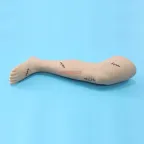17-07-2024
ADA MED SUPPLY LIMITED
Article tag: Surgical suture training model medical clinical model
Through a series of carefully designed characteristics and functions, the surgical suture training model provides trainees with targeted training programs to meet different learning stages and clinical needs. Here's how to do it:

1. Hierarchical training design
The surgical suture training model usually has a hierarchical training scheme from basic to advanced according to the difficulty of surgery and the different requirements of suture. For example, beginners can start with the most basic skin suturing and gradually transition to more complex suturing techniques such as muscle layer and blood vessel anastomosis. This layered design helps students master the stitching skills step by step, ensuring that each step is solid and reliable.
2. Diversify simulation organizations
A variety of simulated tissue materials are used inside the model to simulate the different textures and reaction characteristics of real human tissues. These materials include skin, subcutaneous tissue, muscle layers, blood vessels, and more, and each layer is carefully designed to provide a realistic stitching feel. Students can practice repeatedly on these simulated tissues to get familiar with and master the suture methods and techniques of different tissues.
3. Targeted case simulation
In order to meet the clinical needs, the surgical suture training model also designed a variety of targeted case simulation. These case simulations include tumor resection, vascular anastomosis, gastrointestinal anastomosis and other complex surgical scenarios, so that students can be familiar with and master the suture methods and precautions of these special cases in the practice. By simulating real surgical scenarios, students can better adapt to complex situations in clinical work
4. Flexibility and scalability
The surgical suture training model also has high flexibility and scalability. Some models adopt a modular design idea and can be upgraded and extended as needed. For example, different parts or layers of simulated tissue modules can be replaced to suit different training needs. In addition, some models support connectivity and integration with other medical devices or teaching systems to provide more comprehensive teaching resources and support.
In summary, the surgical suture training model provides a targeted training program for students through the characteristics of hierarchical training design, diversified simulation organization, targeted case simulation, intelligent evaluation and feedback, flexibility and scalability. These programs help students to quickly master suture skills, improve surgical skills and adapt to complex situations in clinical work.